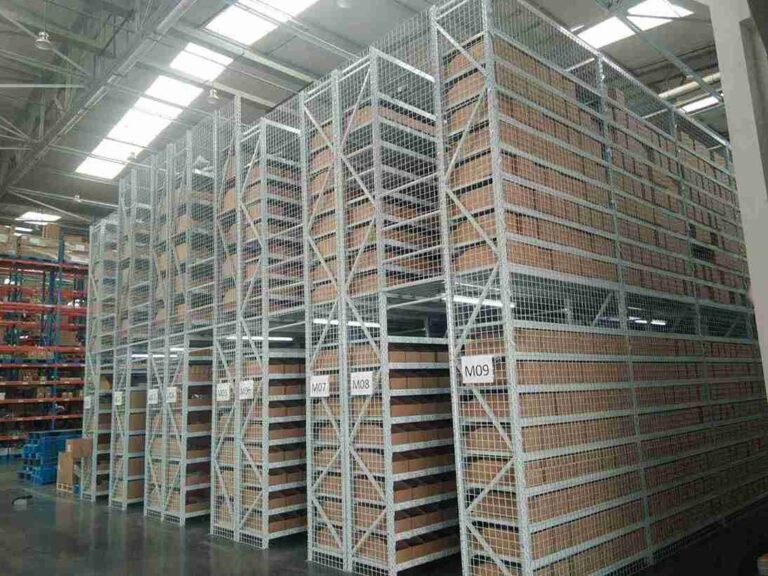📐 "First 50 Enterprise Queries Get Custom 3D Warehouse Design" Plan

Narrow Aisle Forklift + AGV Integration: Cut Handling Costs by 50% in Manufacturing Warehouses
For manufacturing and warehouse operations leaders across the burgeoning industrial landscapes of Southeast Asia, the Middle East, and Latin America, the pursuit of operational excellence is a relentless challenge. The triad of constraints—escalating real estate costs, a volatile labor market, and intense pressure on supply chain margins—demands a radical rethinking of traditional material handling paradigms. The conventional warehouse layout, characterized by wide aisles built for counterbalance forklifts, is increasingly revealed as a monument to inefficiency, sacrificing vast volumes of potential storage space to mere circulation lanes.
The solution, proven in some of the world’s most demanding manufacturing environments, lies not in a single piece of equipment, but in a powerful, synergistic integration. The strategic marriage of high-density Narrow Aisle Storage systems with the relentless efficiency of Automated Guided Vehicles (AGVs) presents a tangible pathway to achieving a dramatic 50% reduction in overall handling costs. This comprehensive guide delves into the mechanics, strategies, and quantifiable return on investment of this transformative approach, demonstrating how forward-thinking operations are turning their storage facilities into a formidable competitive weapon.

The High Cost of Inefficiency: Why Traditional Warehouses Bleed Money
To fully appreciate the revolutionary impact of an integrated Narrow Aisle Storage and AGV system, one must first understand the profound financial drains inherent in conventional setups. A typical manufacturing warehouse designed for counterbalance forklifts dedicates between 40% to 50% of its total floor space to aisles. This design effectively means that a company is paying prime industrial rent or capital costs on a significant area that generates zero storage value.
This spatial inefficiency is compounded by the operational costs of manual labor. Forklift operators, despite their skill, are subject to natural limitations: fatigue, required breaks, variable performance, and the inherent risk of human error. These factors culminate in a ceiling on productivity that is simply unbreachable with traditional methods. A single mis-pick that halts a production line, or a collision that damages both racking and inventory, can erase the profitability of a week’s operations. The integrated Narrow Aisle Storage and automation model directly and systematically attacks these core cost drivers.
The Space Paradox: Paying for Empty Air
The economics of modern industrial real estate make the wide-aisle model untenable. In cities like Bangkok, Dubai, or Mexico City, the cost per square meter of warehouse space is soaring. Every meter occupied by an unnecessarily wide aisle is a direct subtraction from the bottom line. A transition to a Narrow Aisle Storage configuration is the most direct method to reclaim this lost asset.
By re-engineering the storage layout to accommodate aisles as narrow as 1.6 meters, facilities can often increase their storage capacity by 40% to 50% without adding a single meter to their building’s footprint. This Narrow Aisle Storage approach transforms the warehouse from a sprawling, inefficient space into a dense, highly organized inventory hub.
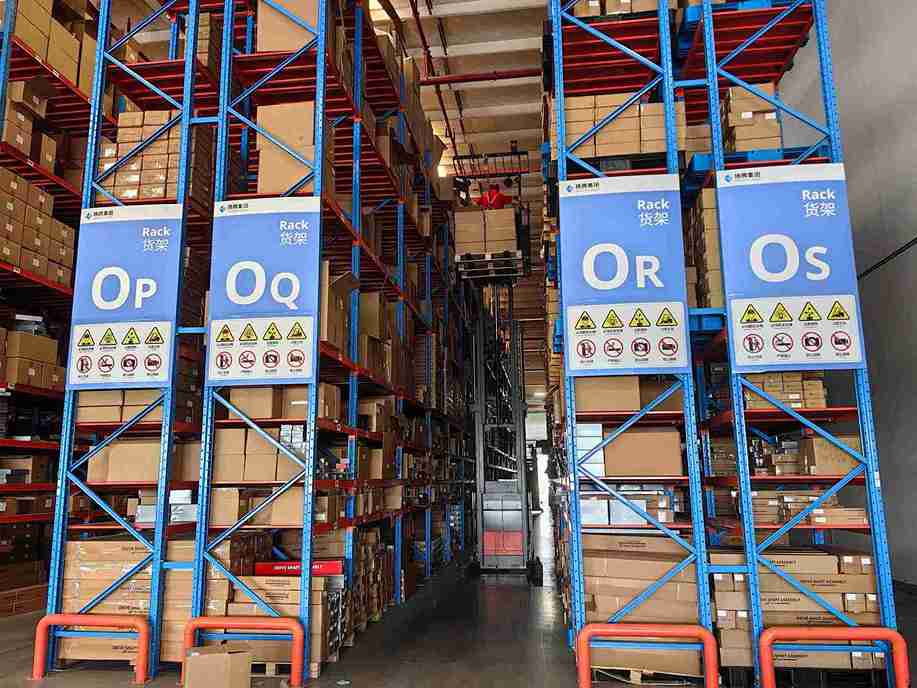
Deconstructing the Density Engine: The Power of Narrow Aisle Storage Systems
The term “Narrow Aisle Storage” refers to more than just a type of forklift; it describes a comprehensive material handling methodology centered on maximizing cubic space utilization. The equipment designed for these environments is highly specialized, engineered for stability and precision in constricted spaces.
Core Equipment in the Narrow Aisle Storage Arsenal
The backbone of any high-density Narrow Aisle Storage system is the specialized truck that operates within it. The two most common types are:
Reach Trucks: These are the workhorses of the Narrow Aisle Storage world. Featuring straddle legs for stability, they can operate in aisles from 2.5 to 3 meters wide. Their defining feature is a pantograph mechanism that “reaches” the load into the racking, allowing for right-angle stacking without the truck itself turning into the rack.
Turret Trucks: Representing the pinnacle of Narrow Aisle Storage efficiency, turret trucks operate in aisles as narrow as 1.6 meters. The fork mechanism rotates 90 degrees left or right, while the truck itself remains stationary in the aisle. This allows the operator to store and retrieve pallets from both sides of the aisle without maneuvering the truck’s chassis, enabling exceptionally high-density Narrow Aisle Storage configurations and dramatically faster cycle times.
The Critical Role of Racking in Narrow Aisle Storage
A true Narrow Aisle Storage system is only as strong as its racking. These are not standard pallet racks. They are typically custom-engineered, high-bay structures designed for exceptional vertical strength and precise alignment. The integrity of the Narrow Aisle Storage racking is paramount, as the clearances are minimal, and the reliance on its stability is absolute. This racking forms the towering, dense canyon walls within which the Narrow Aisle Storage equipment operates.
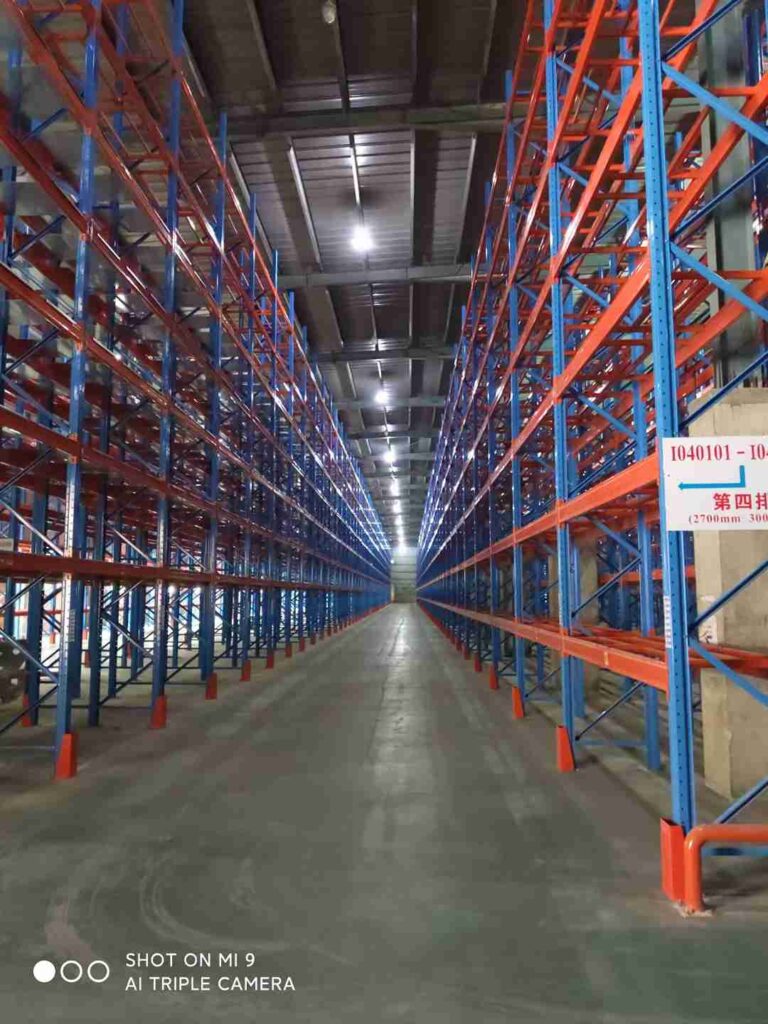
The Autonomous Workhorse: AGVs as the Circulatory System
While the Narrow Aisle Storage system provides the high-density muscle for vertical storage, AGVs serve as the intelligent, autonomous circulatory system that connects the warehouse’s various functions. An AGV is a programmable, unmanned vehicle that follows a guided path, navigating safely around obstacles and personnel to transport materials with unwavering consistency.
Modern AGV Capabilities: Beyond Simple Point-to-Point Transport
The latest generation of AGVs are sophisticated robotic platforms. For seamless integration with a Narrow Aisle Storage system, they are equipped with features such as:
Automated Pallet Handlers: Using fork-based mechanisms, roller beds, or lift decks, they can autonomously pick up and deposit loads at predefined transfer stations.
Advanced Navigation: Moving beyond traditional wire or tape guidance, modern AGVs use LiDAR, natural feature targeting, or vision-based systems. This allows for flexible, easily re-routable paths without physical infrastructure changes, making them ideal for dynamic manufacturing environments feeding a Narrow Aisle Storage area.
Integrated Fleet Intelligence: A central Fleet Management System (FMS) acts as the air traffic controller for the AGVs, optimizing task assignment and routing in real-time to prevent congestion and prioritize critical missions from the WMS that serve the Narrow Aisle Storage zone.
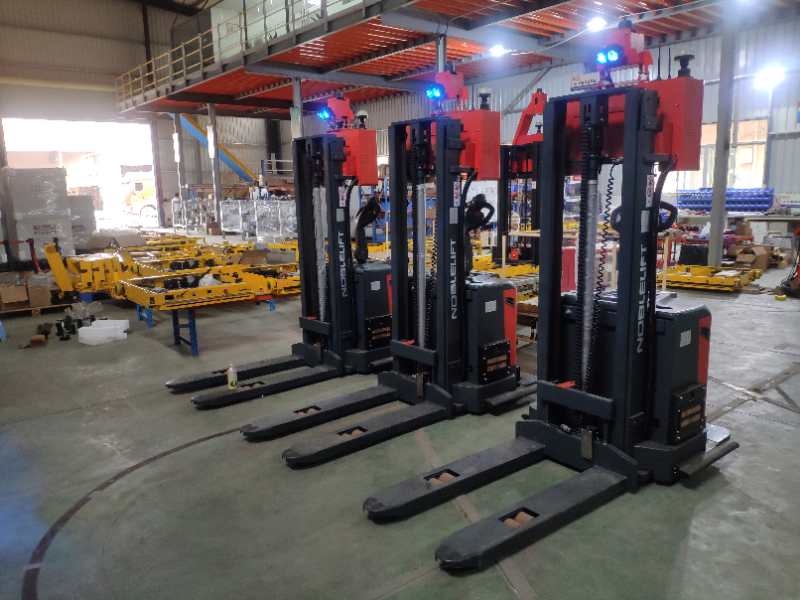
The Blueprint for Synergy: Integrating Narrow Aisle Storage and AGVs for Maximum ROI
The true step-change in efficiency occurs when the Narrow Aisle Storage system and AGVs are not operated in isolation but are woven together into a single, cohesive workflow. This integration is designed around the principle of task specialization, where each technology performs the function it does best, creating a handoff process that eliminates all non-value-added movement.
The “Spine and Ribs” Operational Model
This model, frequently deployed in optimized facilities, perfectly illustrates the synergy:
The AGV Fleet is the “Spine”: This refers to the main horizontal transport routes that connect key zones: receiving, the Narrow Aisle Storage area, production lines, and shipping. The AGVs tirelessly traverse these paths, acting as the reliable conduit for all material movement.
The Narrow Aisle Storage System is the “Ribs”: These are the high-density storage aisles that branch off the main “spine.” The Narrow Aisle Storage trucks—whether manual, semi-automated, or fully autonomous—are dedicated exclusively to the vertical domain of putting away and retrieving pallets within this dense matrix.
A Detailed Workflow: From Receiving to Production
Receiving and AGV Dispatch: A pallet of raw materials is unloaded at the receiving dock. The Warehouse Management System (WMS) instantly tasks an available AGV with the transport mission.
Horizontal Transport to Narrow Aisle Storage: The AGV navigates to the dock, picks up the pallet, and transports it along the “spine” to a designated transfer station at the entrance of the Narrow Aisle Storage zone.
The Narrow Aisle Storage Handoff: The pallet is deposited at the transfer point. This station signals the Narrow Aisle Storage system that a task is pending.
High-Density Putaway: A Narrow Aisle Storage truck, such as a turret truck, retrieves the pallet from the transfer station. The operator (or the automated system) receives the putaway location from the WMS, and the truck proceeds down its narrow aisle to stow the pallet at height, maximizing the Narrow Aisle Storage density.
Retrieval for Production: When the manufacturing execution system signals a need for the material, the WMS generates a retrieval order. The Narrow Aisle Storage truck retrieves the required pallet and places it on an outbound transfer station.
Final-Mile AGV Delivery: An AGV is dispatched to collect the pallet from the Narrow Aisle Storage transfer point and delivers it directly to the precise point-of-use on the assembly line.
This orchestrated process confines the expensive Narrow Aisle Storage equipment to the high-value task of vertical storage and retrieval, eliminating its participation in inefficient long-distance travel. Simultaneously, the AGVs provide a predictable, 24/7 horizontal transport service.
Attributing the 50% Cost Reduction: A Line-Item Analysis
The promised 50% reduction in handling costs is not a vague claim; it is the aggregate result of targeted efficiencies:
Labor Cost Reduction (20-25%): The AGV fleet assumes the bulk of horizontal transport, drastically reducing the number of counterbalance forklift operators required. The remaining Narrow Aisle Storage operators see their productivity soar as they are no longer acting as long-haul drivers.
Space Utilization Monetization (15-20%): The implementation of a Narrow Aisle Storage system directly converts previous aisle space into revenue-generating storage positions. This either defers massive capital expenditure on a new facility or allows for the consolidation of multiple warehouses into one.
Error and Damage Elimination (8-12%): AGVs do not experience fatigue or distraction. Operating within the precise confines of a Narrow Aisle Storage system, the potential for racking damage is minimized. The result is a near-zero rate of shipping errors, production stoppages, and inventory write-offs.
Energy and Predictive Maintenance Savings (5-7%): Both Narrow Aisle Storage equipment and AGVs are predominantly electric, with regenerative braking and smart power management. Their predictable operational patterns allow for a shift from reactive repairs to predictive maintenance, further controlling costs.
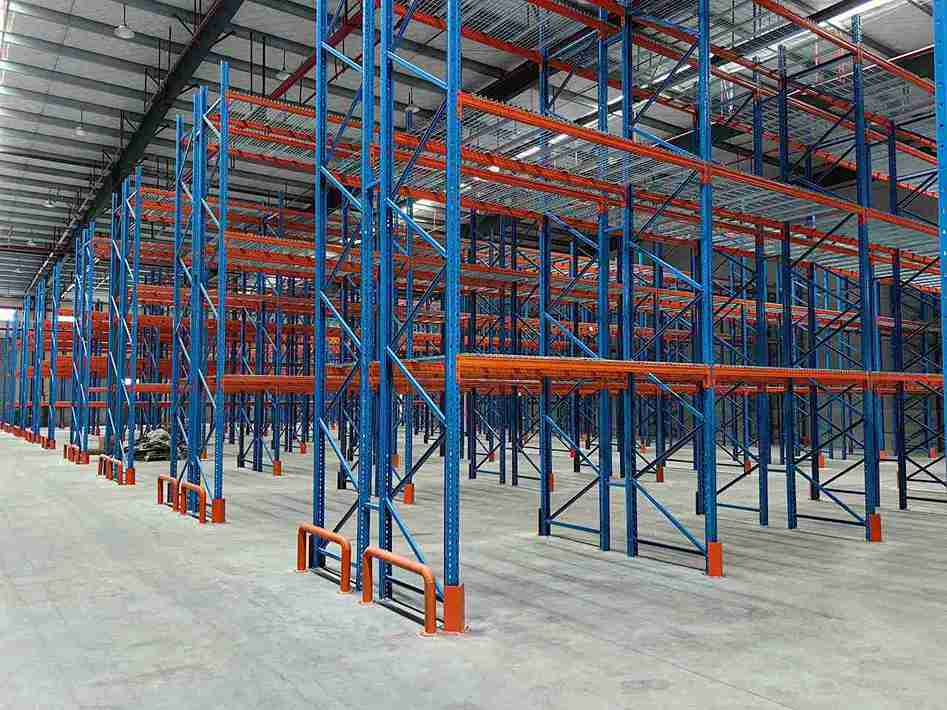
Implementation in Emerging Markets: A Pragmatic, Phased Approach
Global enterprises are not the only ones who can benefit from this integration. The model is highly adaptable to the specific conditions of growth markets, where flexibility and scalability are key.
Phased Rollout: Mitigating Risk and Proving Value
A phased implementation is the most effective strategy for managing capital outlay and organizational change management.
Phase 1: The High-Density Pilot Zone. The project begins with the design and installation of a Narrow Aisle Storage system in one segment of the warehouse, for example, a section dedicated to high-turnover raw materials. Existing staff are trained on the new Narrow Aisle Storage equipment, delivering an immediate boost in storage capacity for that SKU range.
Phase 2: Introducing AGV Horizontal Transport. A small fleet of AGVs is deployed to handle all material movement to and from this pilot Narrow Aisle Storage zone. This phase delivers irrefutable data on transport efficiency and labor reduction, building internal confidence and solidifying the ROI calculation.
Phase 3: Full-Scale Integration and Expansion. With the model proven, the Narrow Aisle Storage concept can be rolled out across the entire facility. The AGV fleet is expanded, and its pathways are optimized to create a fully integrated, high-throughput material handling ecosystem.
Technology Selection for Demanding Environments
When selecting equipment for markets where technical support may be less readily available, durability and remote diagnostics are paramount. Partners should provide Narrow Aisle Storage trucks and AGVs built with robust components, easy-access service points, and comprehensive telematics systems that allow for remote monitoring and troubleshooting, ensuring maximum uptime.
Addressing the Core Objections to Automation
Adopting this advanced model naturally invites scrutiny and questions. Addressing these concerns with data and clarity is crucial.
“The Capital Expenditure is Prohibitive.”
This integration should be analyzed as a strategic capital investment, not a simple expense. A detailed ROI analysis consistently shows payback periods between 18 and 36 months. The savings are not hypothetical; they are realized in hard cash through reduced payroll, avoided expansion costs, and the virtual elimination of error-related losses. After the payback period, the savings translate directly into improved profit margins and a stronger competitive position.
“Our Warehouse Layout is Too Irregular or Constrained.”
Modern AGV navigation technologies are remarkably flexible. Laser-guided or vision-based systems can navigate complex and dynamic environments without requiring major structural modifications. A professional site survey can determine the feasibility and any necessary minor adjustments, such as reinforcing a section of flooring or installing a single transfer point, to integrate with the Narrow Aisle Storage system.
“We Will Lose Operational Flexibility.”
In reality, the system grants superior, data-driven flexibility. Changing a production schedule or accommodating a new product line simply requires reprogramming the software, not re-training an entire workforce or physically reconfiguring the warehouse layout. The AGV paths and the WMS directives governing the Narrow Aisle Storage zone can be adapted overnight, providing a level of agility that manual systems cannot match.
Conclusion: Forging a Competitive Advantage Through Integrated Automation
The landscape of global manufacturing and logistics is being reshaped by intelligent automation. For companies operating in the fast-growing economies of Southeast Asia, the Middle East, Africa, and Latin America, clinging to outdated material handling models is a significant strategic risk. The integration of high-density Narrow Aisle Storage systems with a flexible fleet of AGVs is no longer a futuristic concept; it is a commercially proven, readily available solution to the most pressing cost and efficiency challenges.
This approach systematically dismantles the pillars of operational waste—excessive space consumption, unsustainable labor costs, and costly human error—replacing them with a resilient, scalable, and data-rich model. By transforming the warehouse from a static cost center into a dynamic, high-throughput engine, businesses can secure a decisive advantage in an increasingly competitive world. The journey begins with a single step: a professional assessment to map the specific ROI achievable within your four walls.
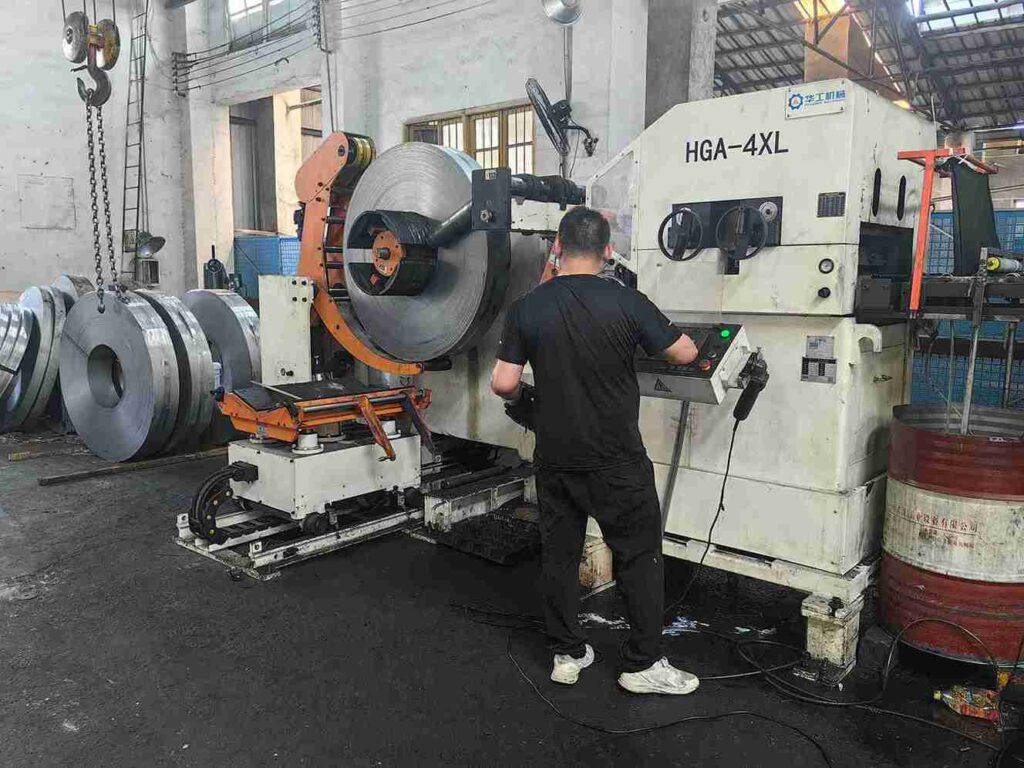
Frequently Asked Questions (FAQs)
1. Can a Narrow Aisle Storage system be retrofitted into an existing warehouse with standard racking?
While it is physically possible, it is generally not recommended. A true, safe, and efficient Narrow Aisle Storage system requires racking that is engineered for the specific loads, heights, and narrow clearances. Standard racking may not have the required vertical alignment or strength, risking damage to both the racking and the expensive Narrow Aisle Storage equipment. A professional audit is essential to determine if retrofit is feasible or if a new Narrow Aisle Storage structure is the wiser investment.
2. How does the integration impact inventory management and stock accuracy?
The impact is profoundly positive. The WMS becomes the single source of truth, and every movement—orchestrated by the AGV and Narrow Aisle Storage system—is executed based on a digital order. This eliminates mis-picks and lost inventory, as every pallet is accounted for in a specific location within the Narrow Aisle Storage matrix. Cycle counting becomes faster and more accurate, often leading to inventory accuracy rates of 99.9% or higher.
3. What are the power requirements for operating a large AGV fleet and Narrow Aisle Storage equipment?
Both systems are predominantly electric. A detailed analysis is needed, but facilities must plan for adequate charging infrastructure. Smart charging strategies, such as opportunity charging during breaks or battery swap systems, can mitigate the need for a massive increase in electrical capacity. The energy consumption of a fleet of efficient electric AGVs and Narrow Aisle Storage trucks is often lower than that of a comparable fleet of internal combustion forklifts.
4. Is the 50% cost reduction sustainable in the long term, or does it diminish over time?
The cost reduction is highly sustainable. The largest components—space and labor—are permanently optimized. The savings from avoided facility expansion and a reduced headcount are recurring year after year. Furthermore, the predictive maintenance models and robust construction of the equipment lead to stable, manageable operating costs, protecting the ROI long into the future.
5. How does this system handle a power outage, and what are the contingency plans?
Robust systems are designed with contingency in mind. AGVs have manual override controls and can be moved manually in an emergency. The Narrow Aisle Storage trucks can also be operated manually. Furthermore, critical components like the WMS and Fleet Management software can be hosted on backup power or cloud-based systems. A comprehensive implementation plan always includes Business Continuity and disaster recovery protocols to ensure operations can be restored quickly.
If you require perfect CAD drawings and quotes for warehouse racking, please contact us. We can provide you with free warehouse racking planning and design services and quotes. Our email address is: jili@geelyracks.com

